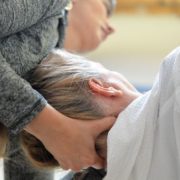Neck Pain During Crunches? Here’s Why & How to Avoid it
Abdominal crunches are one of the most popular “ab exercises” around. It’s a movement that emphasizes upper abdominal strength. You start by lying on your back, typically with your hands behind your head and knees bent. You then lift your head and chest off the floor, “crunching” your upper body into a C-shaped curve.
Over the years, many “experts” have dismissed this exercise, claiming it’s ineffective for core strengthening. While I agree that it shouldn’t be the ONLY core exercise you do — the crunch does have its place. I work on this a lot with my private clients, because it’s a functional move that when done correctly, will help you sit up from the floor with more ease and with less risk of injury. And of course you see variations on this movement all the time in Pilates, which is a key part of our practice and our efforts to help people recover from back pain.
I often hear that people don’t like crunches because they’re uncomfortable or hurt your neck. But when you’re doing a crunch, you want to make sure you’re feeling it in your abs… NOT in your our neck. Here are the biggest problems I see with crunches and how to tell if it’s a technique problem or a neck problem:
You’re not actually using your abs
This sounds pretty obvious, right? But a lot of people have trouble figuring this out. During our Pilates 101 class this week, one woman experiencing neck pain appeared to be doing the move correctly — but she couldn’t feel it in her abs, only in her neck.
It’s because she was using her neck and chest muscles to curl her upper body into the crunch instead of initiating the move from her belly (abs). My tips to correct this were to pull her lower belly in toward her spine and the front of her ribs down toward her belly button. Then, keeping this shape locked in, use her breath (exhale) to help her initiate and start the curl from her abs.
Sometimes people don’t have the abdominal strength yet to perform a crunch from lying flat. If that’s the case, you won’t be able to do this correctly no matter how well you follow my cues. If you think that’s your problem, place a small pillow under the back of your head. This gives you a head start into the curl. Once your abdominals get stronger, you can try doing the crunch with your head starting from the floor again.
Your neck is in the wrong position
When you’re doing a crunch, you want your neck to be slightly curled (chin toward chest). Most people either curl their neck too much, or not enough. If your chin is touching your chest, you’re curled too much. And if you feel your chin and neck jutting forward toward the ceiling, you’re not curled enough. Either of these positions could lead to neck problems down the line if not corrected.
The ideal position for your neck is to begin with a slight nod of the chin (like you’re nodding “yes”) and then keep it there. The rest of the curling motion will come from contracting your trunk and abs. As you curl up, I recommend keeping your eyes focused on your belly and keeping a tennis ball’s distance between your chin and your chest.
Sometimes your hand and arm position can be what causes your neck to be in the wrong place. If your hands are behind your head, be sure you’re not using them to pull your neck forward. Your head should be gently pressing into your hands and your elbows should be at a 45 degree angle from your body. Your abs do the rest.
You have an underlying neck problem
In our practice, we specialize in neck and back pain. When you’ve got an underlying neck problem, doing crunches isn’t a good idea until the underlying problem is resolved.
Let’s say you have a small bulging disc in your neck that you weren’t aware of or that you thought was fixed. The curled position of your neck during a crunch can exacerbate this problem, even if you are using your abs correctly and following every tip I just mentioned above.
Some clues that you might have an underlying neck problem could be pain that shoots into your shoulder blade or numbness and tingling down your arm. You might experience these symptoms during the movement, or even up to several hours after.
Either way, symptoms like this could be a sign that there is more to your neck pain than simply incorrect crunch-technique or weakness in your abs.
If this is happening, it’s a good idea to get it checked out by a movement/mechanical specialist like the physical therapists in our practice. The good news is that we can help your neck feel better even if you do have a problem like bulging discs — and you can get back to doing crunches again without any neck pain.
You can also check out our FREE guide to neck and shoulder pain right here!
It comes right to your email inbox and explores seven easy ways (plus a bonus section!) that are PROVEN to help you ease neck and shoulder pain quickly – without pain medication, procedures, or surgery.
If you have any additional questions or want a more personalized assessment, sign up for a FREE Discovery Session with us! It’s a quick, no-obligations opportunity for you to see if working with us could be the best decision for your health.


